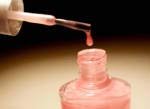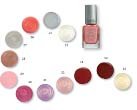 usa.netflixcehennemi.top
usa.netflixcehennemi.top 
In addition to the color range, varnishes are distinguished by their composition, properties, manufacturers.
A good varnish does not dry out after half a year, but it also has its expiry date. To make the varnish more liquid can be with the help of solvents, but this can be done when the varnish is slightly thickened, but not completely dried. You can not wait for miracles from solvents - after two or three applications, the varnish will still come into disrepair, lumps, bubbles will appear, will not be applied evenly.
To distinguish just a good varnish from a bad one, you can only try it on your nails. But several principles of choice should be followed when buying:
Color - looking at the window with varnishes, try to imagine the color you liked on your nails, perhaps you will immediately understand that this color will not suit you.
Remember that the samplers on white paper do not reflect how the lacquer on your nails really will look. On the probe you can estimate the transparency, ie in how many layers you will need to superimpose it. If the varnish is very clear, then it is better to apply it on any more dense lacquer serving as the basis for your manicure. Adequately, the color can be estimated from the finished samples of the colored nail in the store.
Be sure to take the bottle in hand, evaluate the consistency - the drop from the brush should fall for 5 seconds, otherwise the varnish is too thick. It will be badly applied and will soon dry up.
Examine the brush - the villi should lie flat. A brush - long, soft, with a thin, elastic pile.
Inspect the vial itself - if the label is inaccurately glued, the letters are worn out, the bottle is a curve, scratched, it is better not to buy such a varnish, tk. the external very often reflects the inner.
It is better to buy a varnish with mix balls (metal balls for mixing a varnish). Shaking the varnish, you quickly mix the contents to a homogeneous mass.
Conditionally, we distinguish four groups of varnish producers:
1. Exclusive , expensive, professional and up to us not reaching 2. Professional , whose manufacturers have representative offices in Russia. For example: LCN, Akzent Direct, Creative nail design, OPI. There are also manufacturers who have two types of products: professional and conventional. For example: Orly. The possibility of buying professional varnishes (products) by private individuals depends on the philosophy of the distributor salon and the manufacturer itself. Some of them sell, some do not. 3. Advertised , sold in cosmetics stores. For example: Revlon, Paloma, Lakme, Avon, Bourjois Paris, Margaret Astor, Meybilen, Green Mama. 4. Selling on the market . There are manufacturers producing just cheap cosmetics, but there are forgeries for famous brands. For example: Golden Rose, Veronigue, Catherine Arley, Gala.Sometimes it is generally impossible to determine the manufacturer of lacquer.
Each of the producers has its advantages and disadvantages. Professional products of the usual quality, of course, different, but not fundamentally. Prof. The varnish is more evenly laid, has a beautiful pronounced color, dries quickly, pleasantly smells. Sometimes you can meet the opposite: a normal varnish is better than a professional one. It should be noted that usually professional products require special knowledge in use.
Prices for varnishes fluctuate:

The usual varnish. The most common and popular. The nail is covered in two layers, excepting black (very dark) in one, and white (very light) in three.
Pearl. Mother-of-pearl ebb tide, good durability. It has a visible structure, so when applying, the brush should be drawn exactly from the base to the edge.
Clear nail polish. It is used as a base and as a coating varnish. Protects nails and gives them shine. Makes the color more vivid. The composition includes aniline dyes. Protection from the coloring of the surface of the nail because of the bright color varnish.
Lacquer base. Serves to smooth the surface of the nail. It is pink, transparent.
Quick-drying. Express varnishes. They dry up in one minute.
With sequins. Transparent (colored) varnish with the addition of shiny tinsel of different shapes, sizes, colors.
Matt. "Matte frost". Does not have the usual varnish glow. The surface is smooth, velvety. Instantly dries and for some reason smells of camphor oil. Thick lacquer.
Single-layer varnish. Coats the surface with a single-layer coating.
Firming. Are applied after the manicure. Contain liquid silk fibers and keratin. Protect from the effects of the environment. Nails become harder.
Bitter. Has a bitter taste and serves as a defense against the habit of biting your nails. Usually green-transparent color.
Hypoallergenic. Do not cause contact allergy, t. do not contain toluene-sulfonamide-formaldehyde resin, and mix balls do not contain nickel. This varnish can be purchased at the pharmacy.
Chameleon. Changes the color (shade) depending on the angle of the nail.
Temperature. Gradually changes color depending on the temperature of the surface of the nail. Indoors and outdoors.
The effect of "old porcelain." The surface seemed cracked with time, cracks are visible. After application in 3 seconds, the upper layer begins to shrink.
Watercolor. Transparent varnish with different shades. It has a more shiny surface than a regular varnish, as if it has not completely dried up yet. Gives delicate, pleasant colors. It is good to use with a jacket - it smooths the sharp border between the free edge (smilie) and the nail bed. Interestingly you can beat the transparency in the nail art, create depth in the composition.
Lucky Dance Legend. The varnish changes color in a nightclub, bowling, casino, at a disco. They appear with UV light in the form of a bright glow: pink, blue, red, turquoise, green.
Cream-varnish. Has insoluble, thick pigments. When applied, strips can form, which in turn can be played in nail art.
Mica. Contains especially large pigments. It has a rough surface.
Peel-off varnish. It is removed from the nail with a single film. Contains special polymers. Water base. This varnish is not suitable for pedicure.
> Varnishes for drawing. More dense and more liquid. There are special professional sets for nail art. They consist of 6 flasks of different colors (for example: cr, blue, black, white, yellow, green). These varnishes are dense and clean in color. You can paint like gouache. Inside the bottle is a special brush for drawing strips. It is good to combine, when the background is an unusual varnish (chameleon, mother-of-pearl). Such a set can be found in shops selling cosmetics, in salons, on the Internet. Also, sometimes you can buy a similar varnish and one bottle. For drawing it is convenient to use brushes. It is better to have at your disposal three main brushes: # 1 thin, 1.5 mm long for drawing straight lines and slightly curved lines; №00 thin, length 3 mm for drawing dots, zavoryuchek; №3 fluffy with a sharp tip for covering surfaces, as well as for shaking out different pollen.
Miniature varnishes. The volume is about 3.5 ml. The brush reaches to the bottom, the lacquer does not thicken for a long time, it is consumed almost completely. Can be even in the smallest cosmetic bag.
Varnishes from the collections. Manufacturers produce such varnishes for the season (winter, summer, autumn, spring), to the event (holiday), to the place (dance club), specific (watercolor), hypoallergenic varnish series, soft nail series, etc. All of them have the feature of disappearing from the sale exactly when they are being sold out. Seasonal collections try to reflect the mood of the time of the year to which they are issued. They go to step with the fashion and create it themselves.
Source: nogti.com